- Home
- Tony Hillerman
Coyote Waits jlajc-10 Page 3
Coyote Waits jlajc-10 Read online
Page 3
Leaphorn glanced up at Mrs. Keeyani. She sat with her hands clenched in her lap, lower lip caught between her teeth, watching him.
“I must refresh my memory before I can tell you anything,” he said.
Mrs. Keeyani nodded.
The next page reminded Leaphorn that Ashie Pinto had not made a statement. When apprehended, he had said, according to the report:
“Officer, I have done something shameful.”
Sounded stilted. Leaphorn considered it. Pinto would have spoken to Chee in Navajo, probably. Chee, probably no better than half-conscious, would have passed along a translation to George. George had jotted it into his notebook, retyped it into his report. What had Pinto actually said?
According to the report, nothing else. He had admitted nothing, denied nothing, remained absolutely silent, refusing to answer any question except to confirm his identity with a nod, declining to call a lawyer, to name anyone who he might wish to be informed of his arrest. When asked to submit to the taking of a blood sample, “Subject Pinto was seen to nod in the affirmative.”
The test showed a blood alcohol level of 0.211. The percentage of alcohol in the blood that made one formally and legally drunk in New Mexico was 0.10.
There followed the Federal Bureau of Investigation report dated eleven days following the arrest. Leaphorn scanned it. Ballistics confirmed that the bullet fired into the chest of Nez had come from the pistol confiscated from Pinto, a .38 caliber revolver. It confirmed that holes in Pinto’s trousers were caused by burns. There was more, including the autopsy. Leaphorn knew what it said. Nez had been alive when the fire suffocated him. Probably unconscious, but alive. Leaphorn sighed, turned to the next page. It summarized a statement taken from Chee at the hospital. He scanned it quickly. Familiar stuff. But wait. He lingered on a paragraph. Reread it.
“Officer Chee said that for several weeks Nez had been interested in apprehending an unidentified subject who had been vandalizing and defacing a basaltic outcrop east of Red Rock and south of Ship Rock. Chee said he believed from what he heard on the radio that Nez had seen this person and expected to apprehend the subject. He said the radio signal was breaking up but that he heard Nez laughing and Nez did not appear to want a backup.”
Leaphorn snorted, an angry sound and unintentionally loud. He glanced up to see if the women had noticed. They had.
He covered his embarrassment with a question. “Did anyone tell you about the circumstances?”
“They said he was arrested out there where it happened,” Mrs. Keeyani said. “They said he had the gun that killed that policeman.”
“Did they tell you that he hasn’t denied it?” Leaphorn asked. But he was thinking of Jim Chee. Irritated. Nez did not appear to want a backup. Whether he wanted one or not, the rules said Chee should be there. But that was Chee’s reputation. He made his own rules. Smart. Unusually smart. But not a team player. So he was sitting in the trading post at Red Rock drinking coffee while Nez, alone, was dealing with a homicidal drunk armed with a pistol.
“I don’t know what my uncle told them,” Mary Keeyani said. She shook her head.
“But I know he didn’t do it. Not Hosteen Pinto. He wouldn’t kill anybody.”
Leaphorn waited, watching her face, giving her a chance to say more. She simply sat, looking down at her hands.
Finally she said: “A long, long time ago, before I was born
He got in a fight then, when he was young, and a man was killed. But he was a wild boy then, and drunk. Now he is an old man. He doesn’t drink now. Not for years.”
It was not something to argue about. Instead Leaphorn said, “He won’t tell them anything at all. That’s what I’m told. Not a word. Not even to his lawyer.”
Mrs. Keeyani looked at her hands. “That wasn’t his gun,” she said. “My uncle had an old .22 rifle. A single-shot rifle. He still has that. It’s in his hogan.”
Leaphorn said nothing. This interested him. That pistol Pinto had was a Ruger, an expensive model and not what you would expect a man like Pinto to own. On the other hand, there could be a thousand explanations of why he did own it.
“Perhaps you didn’t know about this pistol,” Leaphorn said.
Now it was Mrs. Keeyani’s turn to be surprised. “He is my mother’s brother,” she said. “He never got married. His place was there at our grandmother’s place behind Yon Dot Mountain.”
Leaphorn needed no more explanation. If Ashie Pinto had owned an expensive Ruger revolver, his relatives would have known it. He glanced back at the FBI report, looking for the name of the investigating officer. Agent Theodore Rostik. He’d never heard of Rostik, which meant he was a newcomer to the Gallup officeeither fresh and green from the FBI Academy, or an older agent exiled as a lost cause. Up-and-comers in the agency were not sent to places like Farmington, or Fargo, or Gallup, or other towns considered Siberian by the Bureau hierarchy. These were the billets for new men without political connections in the agency, or those who had fallen from graceperhaps having caused bad publicity (the agency’s mortal sin) or shown signs of original thinking. For Leaphorn the point was that Rostik might be unusually stupid, or unusually smarteither of which might cause his exile. But most likely he was simply green.
“I’ll tell you what I think you should do,” he said to Mrs. Keeyani without looking up from the report. “Hosteen Pinto has a lawyer who may be green but will be smart. The Federal Public Defender just hires the smart ones. Work with her. Tell her the strange things that trouble you. She will send out one of the investigators to learn the facts. I know one of them personally, a very good man. You should work with them.”
Leaphorn read on, not looking up, waiting for a response. He heard Mrs. Keeyani shift in her chair. But the voice he heard was Dr. Bourebonette’s. “Are they Navajos?” she asked. “Would they understand that Hosteen Pinto’s family would certainly know if Hosteen Pinto owned that pistol?”
“Maybe not,” Leaphorn said. He didn’t look up because he didn’t want to show his resentment. Mrs. Keeyani he could tolerate. He respected her reason for being hereeven though it wasted her time and his. Professor Bourebonette was another matter. But it was an astute question.
“Probably they wouldn’t understand that,” he agreed.
He was looking for something in the report that would tell him how Ashie Pinto had gotten from his place behind Yon Dot Mountain to Navajo Route 33 south of Ship Rock, New Mexico. Two hundred miles, more or less. Nothing in the report mentioned an abandoned car or pickup.
Dr. Bourebonette cleared her throat politely. “Does that report tell how Hosteen Pinto got over into New Mexico?”
“I was looking for that,” Leaphorn said, glancing up at her. “Do you know?”
“Someone came and got him,” she said.
“Who?”
Dr. Bourebonette glanced at Mary Keeyani.
“I don’t know,” Mary Keeyani said. “But I know somebody came and got him. I had gone over to the store at the Gap to get some kerosene for the light. And my husband, he was out with the sheep. Everybody was gone somewhere except my youngest daughter. She had come home on the school bus and she’d gone out to catch her horse and go help with the sheep and she saw dust from the car.”
“It wasn’t Pinto’s car?”
Mrs. Keeyani laughed. “Hosteen Pinto’s car broke a long time ago,” she said. “The chickens sleep in it.” Her amusement left as quickly as it had come. “She was up on the side of the hill with the horse and all she saw was the dust and maybe just a glimpse. It had come from Hosteen Pinto’s shack. The road, it runs right by my mother’s hogan and past our house and then out toward Twentynine Mile Canyon and connects up with the road to Cedar Ridge Trading Post. She said it might be a light-colored car, or maybe a pickup, or maybe it was just dusty.”
“When was this?”
“It was the evening before Hosteen Pinto got arrested over in New Mexico.”
Leaphorn flipped back through the report. He found
nothing about any of this.
“Did a policeman come to talk to you?”
“A young white man,” she said. “With those little spots on his face. And a Navajo to translate for him.”
Freckles, Leaphorn thought. A culture unafflicted with freckles has no noun for them. “What did they want to know?”
“They asked about the pistol. They asked about what Hosteen Pinto was doing over there. Where did Pinto get the pistol? Where did he get the two fifty-dollar bills he had in his pocket? Did Hosteen Pinto know Delbert Nezthe man they say he shot? They asked questions like they thought Hosteen Pinto was bootlegging wine. Like how did Hosteen Pinto act when he was drunk? Did he get into fights? How did he make a living? Was he a bootlegger?” Mrs. Keeyani had been looking down at her hands. Now she looked up. “They seemed to think for sure he was a bootlegger.” She shook her head.
“How did you answer?”
“I said maybe the fifty-dollar bills were his fee. From the one who came and got him.”
“Fee?”
“He had his crystals with him,” Mrs. Keeyani said. “When he was younger he used to work finding things for people. When I was a little girl they would come from as far away as Tuba City, and even Kayenta and Leupp. He was pretty famous then.”
“He was a crystal gazer,” Leaphorn said. He leaned forward. If this man was working as a shaman, maybe there was more to this than just another senseless, sordid whiskey killing. “He still worked at it?”
“Not much.” She thought about it. “Last year he found a horse for a man who works over at Copper Mine, and then he did a little work for a white man. And he would work with Dr. Bourebonette.” She nodded at the professor. “That was about all I know about.”
“What had the white man lost?”
“I think he was hunting old-time stories.”
Leaphorn wasn’t sure what she meant. He waited for an explanation. None came.
“Was Hosteen Pinto someone the anthropologists came to see to learn the old stories? Like Professor Bourebonette?”
“Yes. Many times in the old days. Not so much now. He learned most of them from Narbona Begay I think. The brother of his mother.”
“You think it was this white man looking for stories who came for him the day before the shooting?”
Mrs. Keeyani shook her head. “I don’t know who it was. Maybe.”
Or maybe not, Leaphorn thought. And how does it help anyway? His mind kept returning to Dr. Bourebonette’s reason for being here. She knew the man, obviously. She said she liked him, had worked with him. But being here involved a lot of time and effort if you worked in Flagstaff. And she also seemed ready to pay for the expense of a private investigator.
“Are you still working with Hosteen Pinto?” he asked her. “I mean something current? Going on right now?”
She nodded. “We have been collaborating on a book,” she said.
“About mythology?”
“About the evolution of witchcraft beliefs,” she said. “Ashie Pinto had noticed it himself. How the stories had changed since his boyhood. He went to Albuquerque with me and we listened to the tapes.
“ She paused. Decided this needed explanation. “The oral history tapes in the University of New Mexico collection. Interviews with elderly Navajos. And not just Navajos. With the other Native American cultures and the Spanish-American old people. Tapes that were made back in the thirties and forties that were recording memories that go way back into the 1880s. And if you allow secondhand, second-person memorieswhat we call grandfather storiessome of the memories went back before the Long Walk. We’d listen to these and look at the transcripts and that would refresh Hosteen Pinto’s memories of the tales he had been told.”
Dr. Bourebonette had an austere face. The only expressions Leaphorn had identified in it were skepticism, anger, and determinationthe face of a woman used to getting her way who doubted she would get it from him. Now Bourebonette’s face had changed. As she talked of this book there was animation and enthusiasm.
Leaphorn decided he might know what motivated Dr. Bourebonette.
“
It’s remarkable,” she was saying.
“What Hosteen Pinto can remember. How well he commands the little nuances of those old stories. The differences in attitudes of the teller toward the witch, for example. The shift in importance if the variation came from outside the Navajo culture. For example, from the Zuni sorcery tradition. Or the Hopi’two-heart’ legends, or” Dr. Bourebonette stopped, midphrase. She looked embarrassed.
“You were still working with Hosteen Pinto? You hadn’t finished?”
“More or less. I was to pick him up later that week. The week it happened. In fact that’s how I found out he was arrested. I had read about the crime, but they hadn’t released Hosteen Pinto’s name. So I went out to his place and Mrs. Keeyani told me he was in jail.”
In jail, Leaphorn thought. Unavailable to answer professorial questions. A book put on hold. Perhaps never to be finished. Professor Bourebonette’s motivations seemed much less mysterious.
“Can the book be finished without him?” Leaphorn asked. His voice was as neutral as he could make it. But Professor Bourebonette read him exactly. Her sharp blue eyes stared into his. “Of course,” she said. But she nodded, conceding his point and accepting the accusation. “But it might not be as solid a work.”
Leaphorn looked away from her, back at the report, impressed with her astuteness and feeling slightly guilty. If he told Emma of this exchange, as he would have, she would have clucked her tongue, disapproving of his conduct. He turned the page, looking for the answer to the obvious question these women had posed. How had the old man gotten from the west side of the Reservation to Ship Rock country? At least he could try to find that out for them.
“It was mostly his book,” Professor Bourebonette said, as if to herself.
Leaphorn glanced up, directly into her eyes. And saw what? Anger? Disappointment?
He flipped through the remaining pages. The question that seemed so obvious to him and his visitors had not seemed so intriguing to Agent Rostik. It simply wasn’t dealt with. Well, perhaps there was some simple, irrelevant answer.
He had intended to ignore the manila envelope of photographs in the back of the folder. They weren’t the sort of images he’d want to share with these women. But now he was curious. He slid the stack out on his desk.
Nez’s body beside the burned car. More burned car, with Chee’s fire extinguisher lying beside it. The pistol, shiny and new looking. A half-dozen shots of the locale taken in daylight, with the tortured, ugly shape of a basaltic outcrop rising in the background over the grassy ridge, a liquor bottle, a pocketknife, odds and ends that the police photographer, or the officer running the investigation, thought might be relevant.
Relevant. Leaphorn picked up the photograph of the bottle. A typical Scotch bottlenothing to distinguish it from most any other, except the cost. He put on his glasses and examined the label.
DEWARS WHITE LABEL
He turned over the photograph. The label on the back confirmed that this was the bottle Ashie Pinto was carrying when apprehended by Officer Chee. “One quart capacity,” the notation added, “approx. five sixth empty.”
Scotch. Expensive Scotch.
“Mrs. Keeyani,” Leaphorn said. “Do you know what Hosteen Pinto likes to drink? Wine? Whiskey?”
Mrs. Keeyani’s face said she resented the question. “He doesn’t drink,” she said.
“He had been drinking that night,” Leaphorn said. “Alcohol was in his blood.”
“He used to drink,” Mrs. Keeyani said. “Just now and then. He’d say if he took one little spoonful he just couldn’t stop. For a long time, he wouldn’t drink, and then somebody would have to go into Flagstaff or Winslow or some place and bring him home from jail. And then he wouldn’t drink any more for a long time. For months. But finally four-five years ago, he did it again, and he got sick in the jail at Flag. Had to go to
the hospital and the doctor said it would kill him. And after that” She paused, shook her head. “No more drinking after that.”
“But when he drank, what did he drink?”
Mrs. Keeyani shrugged. “Wine,” she said. “Anything. Whatever was cheap.”
“How about Scotch?”
Mrs. Keeyani looked puzzled. “Is it sweet?”
“No. It’s very strong and expensive, but not sweet. Why?” Leaphorn asked.
Mrs. Keeyani smiled, remembering. “My uncle had a sweet tooth,” she said. “We used to call him Sugarman. Anything sweet, he loved it. If she saw Hosteen Pinto’s pickup coming, my mother would say, hurry up children, hide that cake I baked. Hide the candy. Hide the sugar sack. Here comes my brother the Sugarman.” She chuckled at the memory. Then, not wanting her mother misjudged, added, “She’d give him a piece of cake.”
“But you don’t know if he drank Scotch?”
“If it was sweet, he drank it. If it was cheap.”
Leaphorn glanced at the photograph of the bottle. The Scotch that came in that was definitely not cheap.
Leaphorn sighed. After a lifetime in police work, he understood himself well enough to know he wouldn’t tolerate this apparent violation of the natural order. He had been curious about how Pinto came to be two hundred miles away from home with no way of getting there, or getting back. But that could be explained by hitchhiking. He could think of no such easy explanation for this bottle of Dewars Scotch. Or two fifty-dollar bills. Or how he got that pistol.
Leaphorn stood.
“Ladies,” he said, “I will see what I can find out.” Chapter 4
JIM CHEE CAME slouching out of the Burn Doctor’s examining room at the University of New Mexico Hospital Burn and Trauma Center feeling distinctly down. Predictions concerning his hand had been ambiguous. Then he noticed the woman sitting against the wall in the waiting room. Something about her reminded him of Janet Pete. She was immersed in a Newsweek, her sleek, dark hair visible above the cover and her very nice legs neatly crossed. He stared. She turned the page of the magazine, giving him a look at more than her forehead.

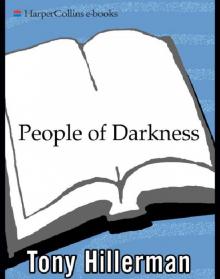 People of Darkness
People of Darkness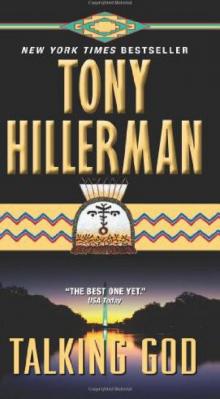 Talking God jlajc-9
Talking God jlajc-9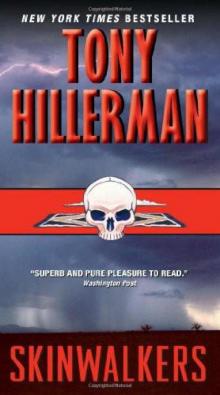 Skinwalkers jlajc-7
Skinwalkers jlajc-7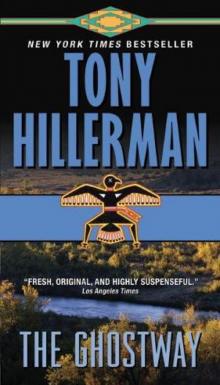 The Ghostway jlajc-6
The Ghostway jlajc-6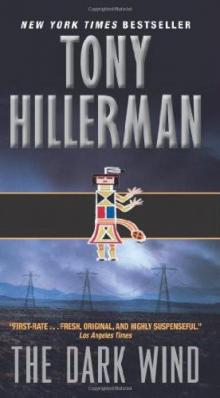 The Dark Wind jlajc-5
The Dark Wind jlajc-5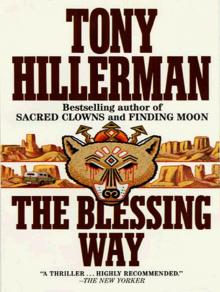 The Blessing Way
The Blessing Way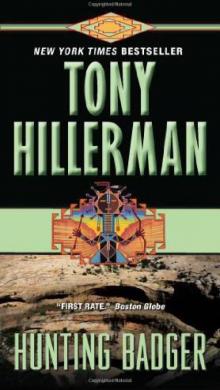 Hunting Badger jlajc-14
Hunting Badger jlajc-14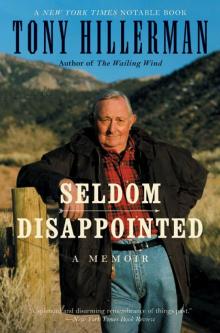 Seldom Disappointed: A Memoir
Seldom Disappointed: A Memoir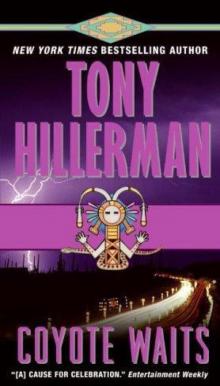 Coyote Waits jlajc-10
Coyote Waits jlajc-10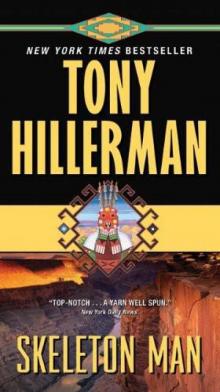 Skeleton Man jlajc-17
Skeleton Man jlajc-17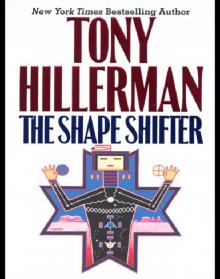 The Shape Shifter
The Shape Shifter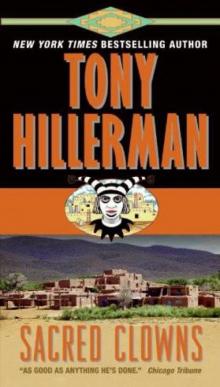 Sacred Clowns jlajc-11
Sacred Clowns jlajc-11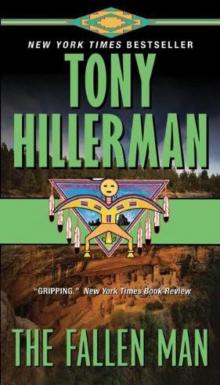 The Fallen Man jlajc-12
The Fallen Man jlajc-12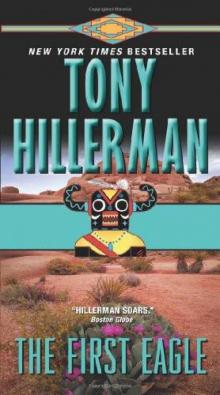 The First Eagle jlajc-13
The First Eagle jlajc-13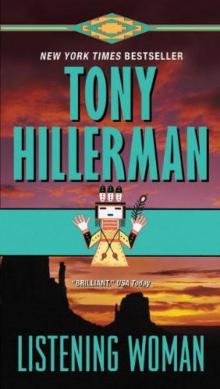 Listening Woman jlajc-3
Listening Woman jlajc-3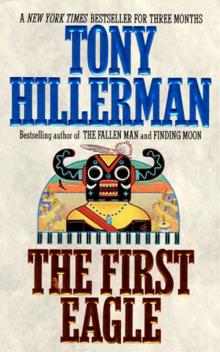 The First Eagle
The First Eagle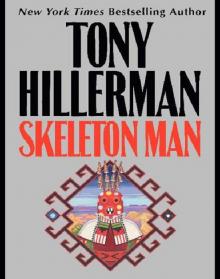 Skeleton Man
Skeleton Man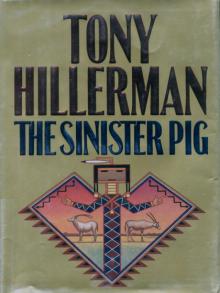 The Sinister Pig jlajc-16
The Sinister Pig jlajc-16 People of Darkness jlajc-4
People of Darkness jlajc-4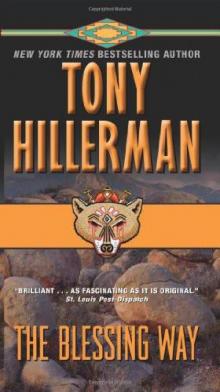 The Blessing Way jlajc-1
The Blessing Way jlajc-1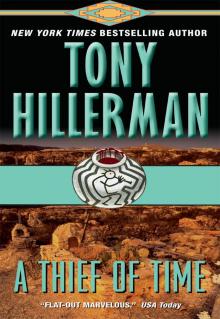 A Thief of Time
A Thief of Time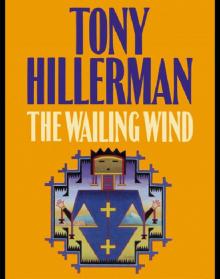 The Wailing Wind
The Wailing Wind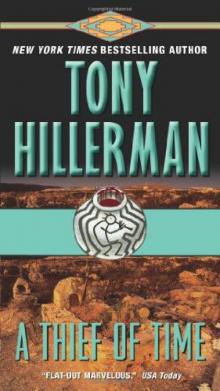 A Thief of Time jlajc-8
A Thief of Time jlajc-8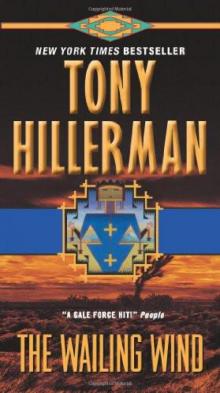 The Wailing Wind jlajc-15
The Wailing Wind jlajc-15 The Shape Shifter jlajc-18
The Shape Shifter jlajc-18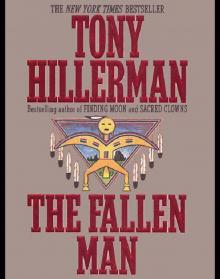 The Fallen Man
The Fallen Man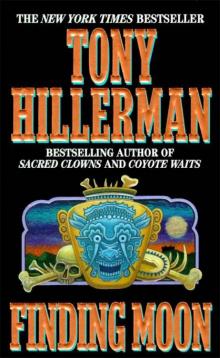 Finding Moon
Finding Moon